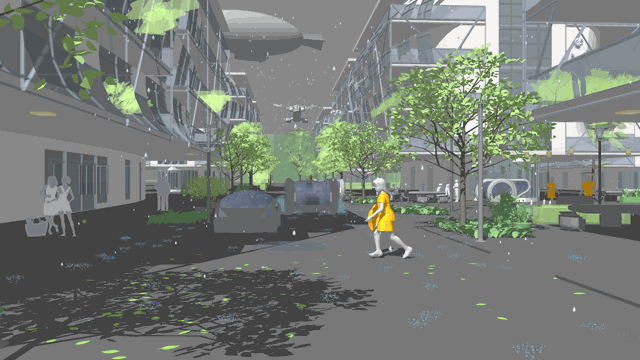Urban simulation with MSPhysics
-
Two exemplary frames of NPR video sequences - day and night simulation - and a GIF snippet of the pure rendering.
The MSPhysics model and the NPR film are still in work. I want to see a few moving branches and relaxed walking people...
Used: MSPhysics, indigo RT, FotoSketcher, VirtualDub, Shotcut and a few models from 3D-Warehouse



-
Wow! That's very nice. Moving Moebius.

-
Wow, completely wow.
-
Blade runner!

-
Looking good! Wow.
-
Thank you all for your "wow".
Fixed camera and only a few moving objects are the best for quick GIF output.
Modeling, animation and rendering for the short final full HD NPR film need a bit more time...

-
Improvement of the effect of the wind from the copter rotors on the leaves and branches.
And improved the particle simulation to reduce the storage volume and rendering effort for the many surfaces.
The raindrops, splashes and water marks appear only in the field of view of the camera depending on speed and direction of movement.


-
Another attempt to add individual moving people.

-
Here's another attempt to get a 3D Warehouse model up and running.
And so I continue to try to simulate upright walking or running with SketchUp and MSPhysics.
Never thought that would be so complex and all parts have to be adjusted exactly..
Mass of body parts, speed, position and programming of the MSP joints, damping, frictional resistance of shoes and ground - everything interacts sensitively.
Running and jumping movements are particularly difficult as the feet tend to break through the ground.
The MSPhysics joints reach their limits and centrifugal forces or shocks, for example, cause the feet to swing out of their imaginary joints.
Falls and fidgeting on the ground are not uncommon during the test runs..

-
Holy moly, this is something, here I am trying to get a frigging treadmill to work with no success and you all Topgun.
I need your skills.
-
Walking is hard for any simulation program and even research labs with millions to spend. You are doing great.
-
Very nice.
I really like the night NPR image. An animation in that style would be awesome.
The only thing missing is some light from the thrusters and maybe some more lights in some of the building.
Great job! -
When it come to motion, you are THE class act. Marvelous.
-


 Faust, with my mouth open I stand there and marvel and I sincerely bow to this class! I love all this even without ever striving or understanding how all this works ... Great!
Faust, with my mouth open I stand there and marvel and I sincerely bow to this class! I love all this even without ever striving or understanding how all this works ... Great! -
Could you elaborate on how you did the animated tree branches simulation?
-
Thanks for the encouraging words!
An animation in the NPR style is my goal. The picture in the first post above is a single frame from an early stage.
There are still missing animated people, other animated objects, lights, etc ..
For the finished one-minute film with a few camera shots, both of my computers each need about 1 week of computation time with an average of 6 minutes of rough rendering per image (1920x1080 pixels, indigo RT).
Next, four movie layers are superimposed in the video editing program - SketchUp Lines-and-Colors, pure rendering, and two graphic layers created with FotoSketcher from the rendered images.
Several filters are used for the overlay then ..

-
The animated tree branches are components extracted from trees, which in this case can be copied arbitrarily and generate a servo joint with a MSPhysics script, wiggle and react to passing copters.
The large blue box in the GIF is the tree dummy with witch all branches self connect.
The GIF shows most of the active simple physics geometry. The geometry to be rendered is too complex for the calculation and is therefore physically ignored. Most smaller objects outside the camera's field of view are hidden. The rain simulation is not shown here.

-
Playing with the architecture - from scaffolding character to more organic shapes in the exterior dungeon of the buildings.

-
Very nice, a brilliant demo of your ability.
-
Here is an attempt to summarize the essential components of the simulation very briefly. In complex MSPhysics simulations, it makes sense to separate the collision geometry from the visual geometry ...

Advertisement







